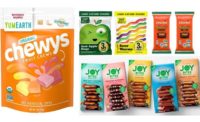When it comes to creating the perfect sweetener it’s hard to compete with the taste of nature’s sugar — but that hasn’t stopped ingredient companies from trying to find alternatives with fewer calories.
“The pressure to reduce sugars is coming from many sides — from consumers, seeking to adopt healthier lifestyles; from healthcare providers, concerned about links between excessive sugar consumption and obesity; and from regulatory mandates, designed to bring more attention to sugar content levels,” says Andy Ohmes, Global Director High Intensity Sweeteners, Cargill.
And all those competing interests means there’s no one perfect solution.
“Not all customers are looking for the same levels of sugar reduction,” Ohmes says. “Some are looking for small reductions, others might be aiming for a no-sugar-added formulation.”
But regardless of the amount of sugar, taste is — and will remain — the single biggest driver of purchase intent, especially in indulgent categories like chocolates and confections, he adds.
Ohmes points to Cargill’s EverSweet as being uniquely positioned to help formulators deliver reduced-sugar and no-sugar-added products that also meet consumer’s taste expectations. In 2018, Cargill began producing commercial quantities of EverSweet, a zero-calorie, next-generation sweetener made with Reb M and Reb D, two sweet compounds that can also be found in the stevia leaf.
EverSweet provides sweetness without bitterness or a licorice aftertaste, creating a more rounded taste profile with a faster onset of sweetness. It is ideal for manufacturers looking for deep calorie reductions, enabling up to 100 percent sugar replacement in certain applications.
“Since the stevia plant produces only trace amounts of Reb M and Reb D, Cargill turned to fermentation to produce EverSweet,” Ohmes says. “This process allows for large quantities of these most sought-after sweet compounds to be commercially produced in a more sustainable way. It also gives us the flexibility to expand rapidly and cost-effectively as the demand for EverSweet sweetener grows.”
Ohmes says Cargill has made tremendous improvements on its stevia products since its first Reb A stevia sweetener was introduced in 2008.
“With the early Reb A products, developers were focused on managing side tastes, such as bitterness, metallic or licorice notes,” he says. “Our researchers saw great potential in the stevia leaf and invested more than 150,000 hours unlocking its secrets. Along the way, we learned how its steviol glycosides act alone and in combination — at both a molecular and sensory level. Today, we know there are more than 70 sweet compounds in the stevia leaf. We’ve identified two of best-tasting compounds, Reb M and Reb D, and we’ve put them to work in our new EverSweet sweetener.”
Royal DSM, a global science-based company in nutrition, health and sustainable living, also launched its AVANSYA Reb M this year.
“AVANSYA is DSM’s new brand for sustainably produced, non-artificial sweeteners that answer to the need for advanced, flexible sugar reduction in a wide range of foods and beverages,” the company says. “The first product in this range is AVANSYA Reb M (Rebaudioside M), a calorie-free steviol glycoside with a pure and clean taste, which is sustainably produced by fermentation.”
AVANSYA Reb M, with its sugar-like sweetness, allows producers to achieve a zero-added-sugar product while maintaining a preferred taste profile in the application. It’s a non-artificial sweetener that’s identical to Reb M found in the stevia plant. It is produced by fermentation, a natural, cost-efficient process that is sustainable and offers consistent, scalable supply. DSM’s novel and patented technology for purifying steviol glycosides from fermentation is completely water-based and solvent-free, which benefits sustainability.
In November, Cargill also expanded its sweetener portfolio with the addition of four label-friendly tapioca syrups. Non-GMO by origin, Cargill’s tapioca syrups feature a full range of carbohydrate profiles and dextrose equivalent (DE) levels and include Certified Organic options, says Scott Helstad, technical service representative, Cargill.
“For customers looking for alternatives to corn syrup, Cargill’s tapioca syrups fit their needs to a tee,” Helstad says. “In creating the new line of syrups, our research and ingredient processing teams worked to develop products with carbohydrate profiles and DE levels that mirror the company’s existing corn/glucose syrups. As a result, the tapioca syrups perform nearly identically, allowing one-to-one replacement with little to no additional formulation work. Cargill’s tapioca syrups are well-suited to confectionery applications such as gummies.”
Tapioca syrup is sourced from cassava, a traditional root vegetable, so it fits the needs of some customers who are seeking label-friendly, non-GMO sweetener alternatives.
Creating reduced sugar chocolate
Of course, when it comes to confectionery, chocolate is the most difficult product to create with reduced-calorie sweeteners.
“In the U.S., chocolate has a standard of identity. So, when you remove nutritive sweeteners like sugars and replace them with other bulking agents like polyols or fiber, it can no longer be called chocolate,” Ravi Nana, polyols technical service manager, Cargill. “In these situations, we use descriptive words like chocolate candy, chocolatey or chocolate coatings.”
But, reducing sugar in chocolate products is complex, as sugar contributes not only sweetness but also to the texture, says Fatemeh Khadem, senior technical services manager, Cargill Cocoa & Chocolate.
“The functionality that sugar has in finished products must be replaced with a blend of ingredients or with an ingredient that is very similar to the profile of sugar from a taste, texture and functionality perspective,” Khadem says. “When selecting and using bulking agents, one must consider water activity, bulk density, processability and other technical factors.”
Manufacturers must also take note of any claim and classification implications that these alternative ingredients may have on the final product, Khadem explains.
“For example, if the bulking agents are not within the standard of identity of chocolate, they may instead be classified as a compound or reduced-sugar chocolate-flavored coatings.”
As companies consider sugar reduction, it’s critical to remember that consumers expect chocolate to be indulgent, Nana says.
“They have high expectations for taste and texture,” Nana says. “High-potency sweeteners do a great job replacing the sweetness of sugar but may need help fulfilling all of sugar’s other functional properties in chocolate. In these situations, we often recommend Zerose erythritol as a good bulking agent. Erythritol has no calories, no sugars and does not raise blood glucose or insulin levels.”
Erythritol also delivers a clean, sweet taste profile, similar to sugar, and it replaces sugar’s bulk at a one-to-one ratio.
“Crystalline maltitol is another option for reduce-sugar chocolate coatings,” Nana says. “With a sweetness of 85-to-90 percent that of sucrose, it works well as a sugar replacement in chocolate coating and has minimal cooling effect.”
One company that has launched a reduced-sugar chocolate this year is Nestlé, which unveiled Milkybar Wowsomes, the first chocolate using Nestlé’s new structured sugar to reduce sugar by 30 percent versus comparable bars.
“The new Milkybar Wowsomes achieves the sugar reduction using only natural ingredients and with no sweeteners,” the company says. “It has milk as the No. 1 ingredient, contains crispy oat cereal and is a source of fiber.”
The sugar reduction comes thanks to a scientific breakthrough that Nestlé first announced in 2016.
“Researchers at Nestlé changed the structure of sugar using only natural ingredients,” the company says. “They created an aerated, porous sugar that dissolves more quickly in the mouth. This allows someone to perceive the same sweetness as before while consuming less sugar.”







